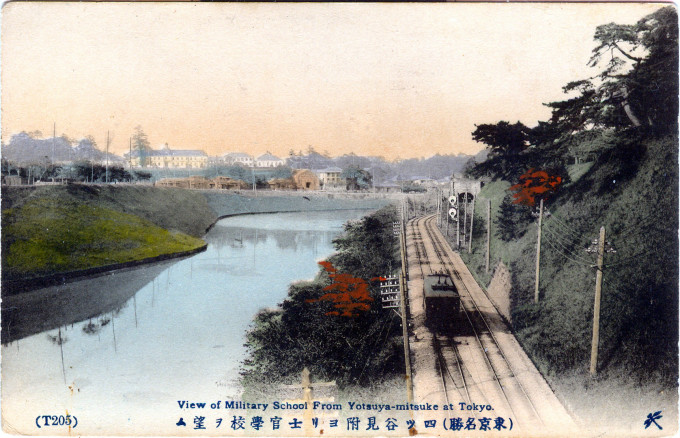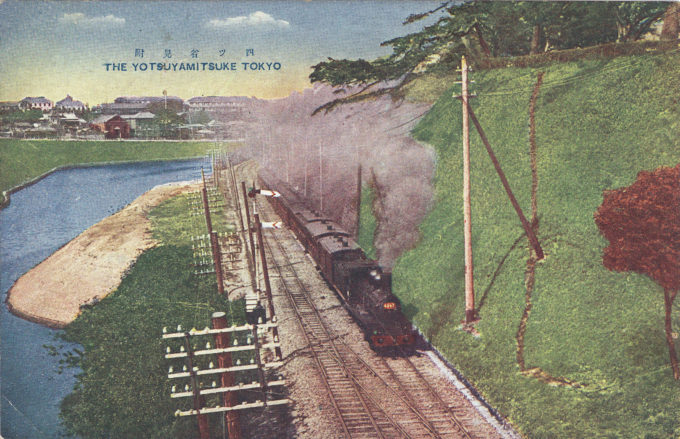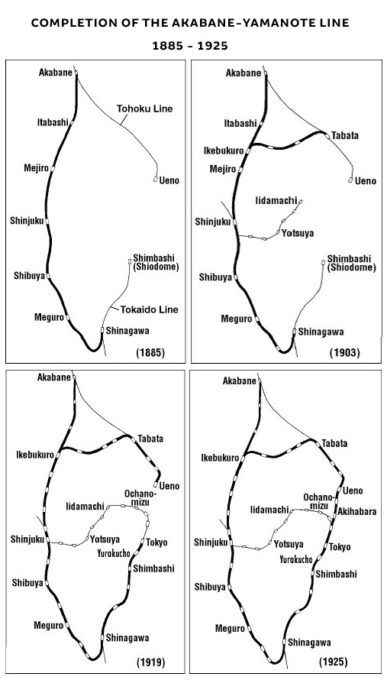
The Kanda River at Ichigaya-mitsuke, c. 1910, as a Chuo Line (neé Kobu Line) train car transits toward Iidabashi station. In 1904, the Chuo Line became Japan’s first entirely electrified railway [between Nakano station and it then-terminus at Iidamachi], and was also the first railroad to use electric passenger carriages. For much of the Chuo Line’s first decade of operations, service levels required only the use of single carriages along its route.
“Another notable railway venture was commence in the outskirts of Tokyo in 1889 – the Kobu Tetsudo.
“The Kobu initially ran from Shinjuku [intersecting] the Akabane line westward a very modest distance to Hachioji, then an important center of the silk industry. But, it was destined to become the first link of a IJGR extension line, call the Chuo (Central) line, that would eventually reach Nagoya and would at last give the military the defensible interior railway line that it had long argued was desirable from the point of view of nation defense, providing an alternative route to the coastal portion of th Tokaido that was so vulnerable to the threat of foreign attack or occupation.”
– Early Japanese Railways, 1853-1914: Engineering Triumphs That Transformed Meiji-era Japan, by Dan Free, 2008

Suidobashi Station, c. 1910, with a passing carriage on the elevated, electrified Chuo Line and a streetcar crossing Suiodobashi bridge.

Map: Chuo (née Kobu) Main Line Developement (1889-1919). Connecting Tokyo with Nagoya, as the more defensible inland main line route favored by the military, the Chuo Main Line followed the general course of the feudal Nakasendo Highway. The inset illustrates the development of the Chuo Rapid Line development betweeen Tachikawa and Tokyo Central Station, 1889-1919. (Click to enlarge)
“The Kobu Railway opened the initial section of the Chūō Line from Shinjuku Station to Tachikawa Station in 1889. The company then extended the line both westward (toward Kofu, ijn 1903) and eastward (toward Tokyo, at Ochanomizu Station, in 1904) until it was nationalized in 1906. Service was further extended into Tokyo at Manseibashi Station in 1912 and Tokyo Central Station in 1919.
“In 1904, the section between Iidamachi Station (formerly located between Suidōbashi Station and Iidabashi Station) and Nakano Station was the first urban electric railway in Japan. Electrification was extended to Tokyo in 1927, and reached Kofu in 1931.”
– Wikipedia

The Kanda River at Yotsuya-mitsuke, c. 1910, with a Chuo Line electrified train approaching Yotsuya Station. In the distance is the Imperial Army Academy at Ichigaya.
“The two train lines, Yamanote and Kobu, and the Sotobori streetcar route mentioned in Katai’s ‘The Girl Fetish’ [1907], had different uses … The Yamanote line opened in 1884 but was not electrified until 1909 and was not convenient for traveling to work or school. It was used for carrying freight. It became a commuter train when its present circle of tracks around what became the heart of Tokyo was completed in November 1925.
“Yoyogi Station, used by the protagonist and schoolgirls of Katai’s story, was constructed in 1893 to serve the first all-electric commuter train begun in 1889, the Kobu railway, called the Chuo or central line after it became part of the national railway network in October 1906 and was the main artery of the Tokyo system.
“The Chuo was the nation’s first urban electric railway [from Nakano to its eastern terminus]. In 1907, it began operating a four-wheeled electric train car with a pole for passengers to grasp for stability, the first vehicle of its kind in Japan. The line was in service from 4:45 a.m. to 11:06 p.m., and a train came every seven minutes.”
– Tokyo in Transit: Japanese Culture on the Rails and Road, by Alisa Freedman, 2011

Chuo Main Line express, from the perspective of Yotusya-mitsuke, Tokyo, c. 1920. While the Chuo Rapid Line – between the Manseibashi terminal and Tachikawa – was electrified, Main Line service west beyond Tachikawa still required steam locomotion. The entire Chuo Line would become electrified in the early 1930s.


